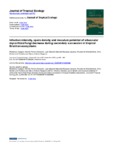Use este identificador para citar ou linkar para este item:
http://www.alice.cnptia.embrapa.br/alice/handle/doc/940931Registro completo de metadados
| Campo DC | Valor | Idioma |
|---|---|---|
| dc.contributor.author | ZANGARO, W. | pt_BR |
| dc.contributor.author | ANSANELO, A. P. | pt_BR |
| dc.contributor.author | LESCANO, L. E. A. M. | pt_BR |
| dc.contributor.author | ALVES, R. de A. | pt_BR |
| dc.contributor.author | RONDINA, A. B. L. | pt_BR |
| dc.contributor.author | NOGUEIRA, M. A. | pt_BR |
| dc.date.accessioned | 2012-12-03T11:11:11Z | pt_BR |
| dc.date.available | 2012-12-03T11:11:11Z | pt_BR |
| dc.date.created | 2012-12-03 | pt_BR |
| dc.date.issued | 2012 | pt_BR |
| dc.identifier.citation | Journal of Tropical Ecology, Cambridge, v. 28, n. 5, 2012, p. 453-462, Sept. 2012. | pt_BR |
| dc.identifier.uri | http://www.alice.cnptia.embrapa.br/alice/handle/doc/940931 | pt_BR |
| dc.description | Little is known about the relationship involving arbuscular mycorrhizal (AM) fungi and functional groups of plants that characterize different phases of tropical succession.We appraised the AM infection intensity of root cortex and spore density in the soil in sites over tropical successional gradients (grassland, secondary forest and mature forest) for several years in Araucaria,Atlantic and Pantanal ecosystems in Brazil. The intensity ofAMinfection decreasedwith advancing successional stages in all ecosystems and it was around 60–80% in early stages of succession, 37–56% in secondary forests and 19–29% in mature forests. Similarly, the AM spore number also decreased with advancing succession and was the highest in early stages (73–123 g?1), intermediate in secondary forests (32–54 g?1) and lowest in the mature forests (10–23 g?1). To verify whether such reductions influenced the potential of AM inoculum in soil, seedlings of Heliocarpus popayanensis (Malvaceae) were grown as test plants in soils obtained from five grasslands, five young secondary forests, and five mature forests in the Atlantic ecosystem. The soil inocula from the grasslands and secondary forests were 7.6 and 5.7 times more effective in stimulating seedling growth than inocula from the mature forests, respectively. Our results show that plant species in grasslands and young secondary forests stimulate the multiplication of AM fungi, leading to a higher potential of the AM inoculum. In later-successional stages, plant investment in AM fungi decreases and the potential of the AM inoculum is also reduced. | pt_BR |
| dc.language.iso | eng | eng |
| dc.rights | openAccess | eng |
| dc.title | Infection intensity, spore density and inoculum potential of arbuscular mycorrhizal fungi decrease during secondary succession in tropical Brazilian ecosystems. | pt_BR |
| dc.type | Artigo de periódico | pt_BR |
| dc.date.updated | 2013-08-20T11:11:11Z | pt_BR |
| dc.subject.thesagro | Fertilidade do solo | pt_BR |
| dc.subject.nalthesaurus | Soil fertility | pt_BR |
| riaa.ainfo.id | 940931 | pt_BR |
| riaa.ainfo.lastupdate | 2013-08-20 | pt_BR |
| dc.identifier.doi | DOI: 10.1017/S0266467412000399 | pt_BR |
| dc.contributor.institution | WALDEMAR ZANGARO., Universidade Estadual de Londrina, Centro de Ciências Biológicas.; ADRIELLY PEREIRA ANSANELO., Universidade Estadual de Londrina, Centro de Ciências Biológicas.; LUIS EDUARDO AZEVEDO MARQUES LESCANO., Universidade Estadual de Londrina, Centro de Ciências Biológicas.; RICARDO DE ALMEIDA ALVES., Universidade Estadual de Londrina, Centro de Ciênicas Biológicas.; ARTUR BERBEL LIRIO RONDINA., Universidade Estadual de Londrina, Centro de Ciênicas Biológicas.; MARCO ANTONIO NOGUEIRA, CNPSO. | pt_BR |
| Aparece nas coleções: | Artigo em periódico indexado (CNPSO)  | |
Arquivos associados a este item:
| Arquivo | Descrição | Tamanho | Formato | |
|---|---|---|---|---|
| 2012JTEv28p453462Zangaro.pdf | 781,36 kB | Adobe PDF |  Visualizar/Abrir |









